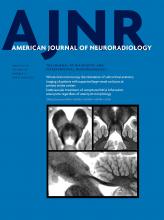Review ArticlePediatric Neuroimaging
Open Access
Understanding Subdural Collections in Pediatric Abusive Head Trauma
D. Wittschieber, B. Karger, H. Pfeiffer and M.L. Hahnemann
American Journal of Neuroradiology March 2019, 40 (3) 388-395; DOI: https://doi.org/10.3174/ajnr.A5855
D. Wittschieber
aFrom the Institute of Legal Medicine (D.W., B.K., H.P.), University Hospital Münster, Münster, Germany
bInstitute of Legal Medicine (D.W.), Friedrich Schiller University Jena, Jena, Germany
B. Karger
aFrom the Institute of Legal Medicine (D.W., B.K., H.P.), University Hospital Münster, Münster, Germany
H. Pfeiffer
aFrom the Institute of Legal Medicine (D.W., B.K., H.P.), University Hospital Münster, Münster, Germany
M.L. Hahnemann
cInstitute of Diagnostic and Interventional Radiology and Neuroradiology (M.L.H.), University Hospital Essen, Essen, Germany
dDepartment of Neuroradiological Diagnostics and Intervention (M.L.H.), Medical Centre Hamburg-Eppendorf, Hamburg, Germany.

References
- 1.↵
- Peterson C,
- Xu L,
- Florence C, et al
- 2.↵
- 3.↵
- 4.↵
- DiMaio VJ,
- DiMaio D
- Di Maio VJ,
- Di Maio DJ
- 5.↵
- Keenan HT,
- Runyan DK,
- Marshall SW, et al
- 6.↵
- Gill JR,
- Goldfelder LB,
- Armbrustmacher V, et al
- 7.↵
- Christian CW,
- Block R
- 8.↵
- 9.↵
- Herrmann B
- 10.↵
- Barlow KM,
- Minns RA
- 11.↵
- Jayawant S,
- Rawlinson A,
- Gibbon F, et al
- 12.↵
- Herrmann B
- 13.↵
- Fanconi M,
- Lips U
- 14.↵
- Jenny C,
- Hymel KP,
- Ritzen A, et al
- 15.↵
- Minns RA,
- Brown JK
- Minns RA,
- Jones PA,
- Barlow KM
- 16.↵Royal College of Paediatrics and Child Health (2013) Child Protection Companion. http://pcouk.org/book.aspx?bookid=1674. Accessed June 9, 2018.
- 17.↵Royal College of Radiologists and Royal College of Paediatrics and Child Health (9/2017). The radiological investigation of suspected physical abuse in children. https://www.rcr.ac.uk/publication/radiological-investigation-suspected-physical-abuse-children. Accessed June 9, 2018.
- 18.↵
- 19.↵
- 20.↵
- 21.↵
- Vinchon M,
- de Foort-Dhellemmes S,
- Desurmont M, et al
- 22.↵
- Kleinman PK
- Hedlund G
- 23.↵
- Case ME,
- Graham MA,
- Handy TC, et al
- 24.↵
- Herrmann B,
- Dettmeyer R,
- Banaschak S, et al.
- Herrmann B
- 25.↵
- Matschke J,
- Glatzel M
- 26.↵
- Osborn AG
- Osborn AG
- 27.↵
- Wittschieber D,
- Karger B,
- Niederstadt T, et al
- 28.↵
- Vezina G
- 29.↵
- Zouros A,
- Bhargava R,
- Hoskinson M, et al
- 30.↵
- Tung GA,
- Kumar M,
- Richardson RC, et al
- 31.↵
- Vinchon M,
- Noulé N,
- Tchofo PJ, et al
- 32.↵
- Hedlund G
- 33.↵
- Case ME
- 34.↵
- 35.↵
- Squier W,
- Mack J
- 36.↵
- 37.↵
- Vinchon M,
- Noizet O,
- Defoort-Dhellemmes S, et al
- 38.↵
- Hwang SK,
- Kim SL
- 39.↵
- 40.↵
- Kleinman PK
- Frasier LD,
- Coats B
- 41.↵
- 42.↵
- 43.↵
- Minns RA
- 44.↵
- Minns RA,
- Brown JK
- Morrison CN,
- Minns RA
- 45.↵
- Yamashima T,
- Friede RL
- 46.↵
- Benninghoff A,
- Drenckhahn D
- v. Düring M,
- Dermietzel R,
- Drenckhahn D
- 47.↵
- 48.↵
- Fox RJ,
- Walji AH,
- Mielke B, et al
- 49.↵
- Lee KS
- 50.↵
- Borzone M,
- Capuzzo T,
- Perria C, et al
- 51.↵
- 52.↵
- 53.↵
- Schachenmayr W,
- Friede RL
- 54.↵
- Friede RL,
- Schachenmayr W
- 55.↵
- 56.↵
- 57.↵
- 58.↵
- 59.↵
- Watanabe S,
- Shimada H,
- Ishii S
- 60.↵
- 61.↵
- 62.↵
- Duhem R,
- Vinchon M,
- Tonnelle V, et al
- 63.↵
- Jenny C
- Tung GA
- 64.↵
- Cramer JA,
- Rassner UA,
- Hedlund GL
- 65.↵
- Bradley WG Jr.
- 66.↵
- Bergström M,
- Ericson K,
- Levander B, et al
- 67.↵
- 68.↵
- 69.↵
- 70.↵
- 71.↵
- 72.↵
- Datta S,
- Stoodley N,
- Jayawant S, et al
- 73.↵
- Adamsbaum C,
- Grabar S,
- Mejean N, et al
- 74.↵
- 75.↵
In this issue
American Journal of Neuroradiology
Vol. 40, Issue 3
1 Mar 2019
Advertisement
D. Wittschieber, B. Karger, H. Pfeiffer, M.L. Hahnemann
Understanding Subdural Collections in Pediatric Abusive Head Trauma
American Journal of Neuroradiology Mar 2019, 40 (3) 388-395; DOI: 10.3174/ajnr.A5855
0 Responses
Jump to section
Related Articles
- No related articles found.
Cited By...
- No citing articles found.
This article has not yet been cited by articles in journals that are participating in Crossref Cited-by Linking.
More in this TOC Section
Similar Articles
Advertisement











